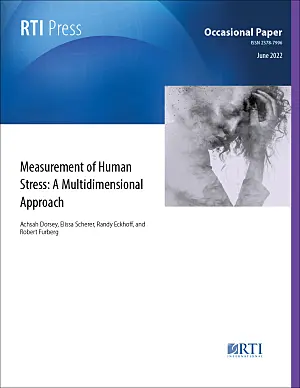Measurement of human stress: A multidimensional approach
By Elissa Marie Scherer, Randall Peter Eckhoff, Robert D. Furberg.
June 2022 Open Access Peer Reviewed
DOI: 10.3768/rtipress.2022.op.0073.2206
- Decades of sociological and physiological research have established the relationship between stressors and human health; however, the measurement of stress differs greatly within this large body of work.
- Establishing a holistic understanding of stress requires assessment of the three domains: (1) the presence of environmental stressors, (2) psychological and biological reactions to stressors, and (3) the length of time over which the stressor or stress response occurs.
- A nuanced understanding of the links between stress and health requires assessment of each of these components in both acute and chronic scenarios; researchers should understand the strategies available to them and the strengths and limitations of each form of measurement before beginning research.
- Future research should favor a multidimensional approach that creates a triangulated picture of stress, drawing from the three method groups covered in this brief: measures of self-report, biomarkers, and digital biomarkers.
Abstract
Stress is a multidimensional construct that comprises exposure to events, perceptions of stress, and physiological responses to stress. Research consistently demonstrates a strong association between stress and a myriad of physical and mental health concerns, resulting in a pervasive and interdisciplinary agreement on the importance of investigating the relationship between stress and health. Developing a holistic understanding of stress requires assessment of the three domains vital to the study of stress: (1) the presence of environmental stressors, (2) psychological and biological reactions to stressors, and (3) the length of time over which the stressor or stress response occurs. Research into all three domains requires multiple methods. Self-reports allow for subjective evaluations of stress that illuminate the duration and severity of the psychological response to stressors. Biomarkers, in turn, capture a more-objective measure of stress and create a deeper understanding of the biological response to chronic and acute stress. Finally, the use of digital biomarkers allows for further exploration of the physiological fluctuations caused by stress by measuring the changes occurring at the same time as the stressor. Future research on stress and health should favor a multidimensional approach that creates a triangulated picture of stress, drawing from each of the three aforementioned method groups.
![]() © 2025 RTI International. This work is licensed under a Creative Commons Attribution-NonCommercial-NoDerivatives 4.0 International License.
© 2025 RTI International. This work is licensed under a Creative Commons Attribution-NonCommercial-NoDerivatives 4.0 International License.
To contact an author or seek permission to use copyrighted content, contact our editorial team


